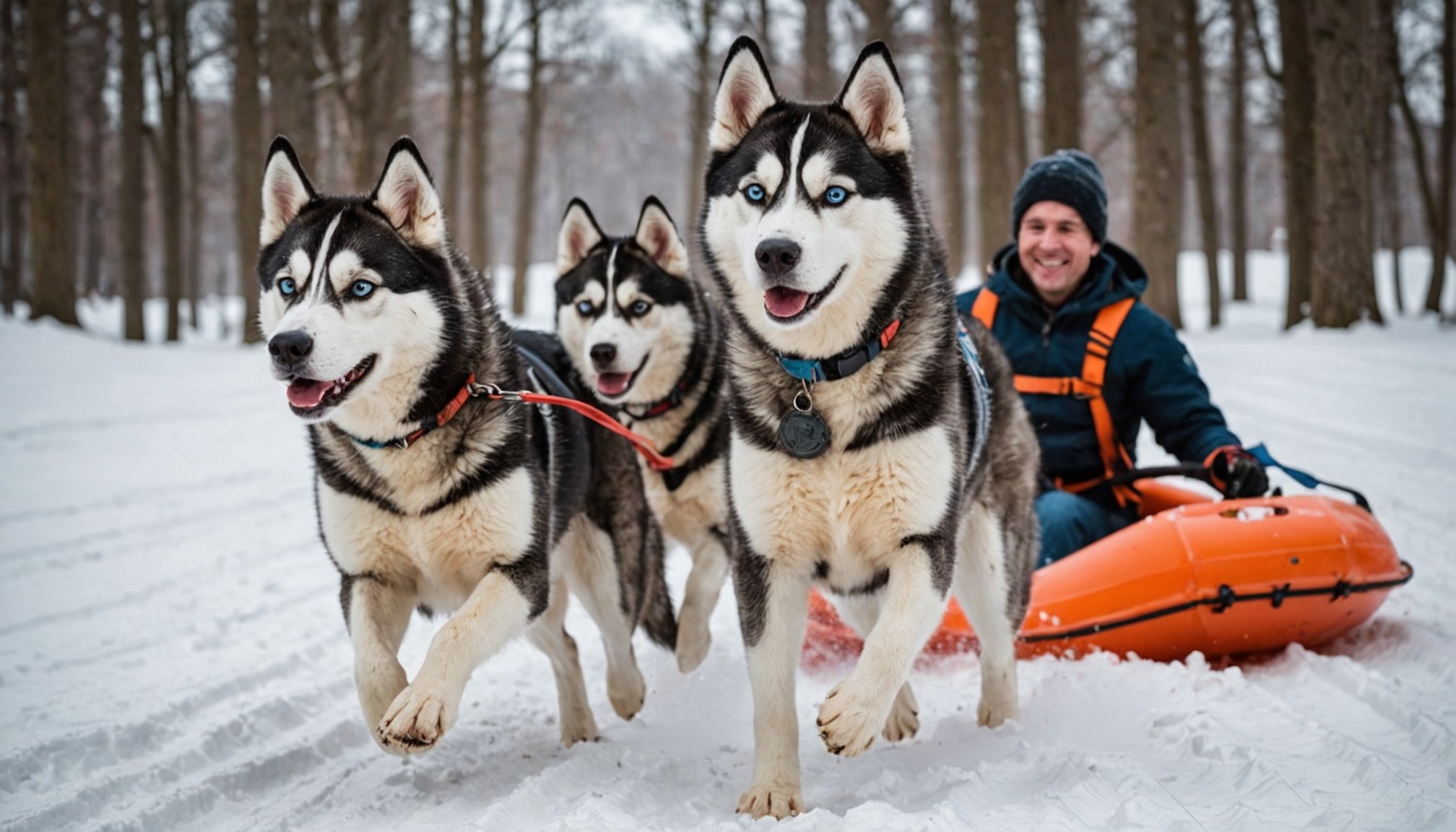Understanding the Siberian Husky’s Temperament and Physiology
Delving into the essence of the Siberian Husky’s characteristics, this breed is renowned for its striking appearance and spirited personality. Originating as sledding dog breeds, Huskies are equipped with a robust physiology that supports their historical role. For effective dog training fundamentals, understanding their exuberant nature and physical capabilities is crucial.
Siberian Huskies are high-energy dogs, thriving on physical activity and mental stimulation. Their enduring capacity allows them to participate readily in activities requiring stamina, making them excellent companions for active individuals. Their natural drive and predisposition for running long distances stem from their history as sled dogs, where endurance was paramount.
Lire également : Mastering socialization: proven techniques to help your shy basenji make friends with dogs and meet new people
The breed’s physiology plays a significant role in their training. Recognising their need for regular exercise is vital in managing their energetic disposition. A well-exercised Husky is more likely to display desirable behaviours, aligning with dog training fundamentals. Engaging them in activities like agility training, running, and, of course, sledding can make use of their natural strengths and keep them mentally satisfied.
Incorporating an understanding of a dog’s physiology into training can foster a harmonious relationship. By satisfying their inherent needs, owners can ensure that these magnificent dogs lead balanced and fulfilling lives.
Lire également : Crucial dietary needs for expecting dachshunds: nourishing your dog for strong and healthy puppies
Essential Training Techniques for Sledding
Training your Husky for sledding requires dedication and a few key sled training methods. At the heart of these methods is obedience training, which serves as the cornerstone for all future sledding ventures.
Begin with basic commands that establish structure, such as sit, stay, and heel. This fosters strong foundational discipline, crucial when introducing more complex dog sledding techniques later. Gradually introduce your Husky to sledding commands and cues. For instance, teach “gee” for right and “haw” for left. Start on short trails to practice turning, then move to longer ones as your Husky becomes more comfortable and efficient.
When implementing these sled training methods, positive reinforcement plays a pivotal role. Reward your Husky with treats or praise whenever they successfully respond to commands. This encouragement not only strengthens their understanding but also builds a bond of trust and enthusiasm in the activity.
Consistency is also vital. Maintain a regular training schedule and reiterate commands during every session. As your Husky becomes familiar with the routine, their responses will be more precise and confident. Ultimately, this combination of obedience training, reinforced commands, and consistent efforts will guide your Husky toward being an adept participant in sledding adventures.
Building Stamina and Endurance for Sledding
To enhance a Husky’s physical endurance for sledding, integrating specific dog stamina training and endurance exercises into their routine is essential. Activities such as long-distance running, swimming, and hiking can significantly improve a dog’s cardiovascular and muscular strength. These exercises should be part of a comprehensive fitness routine for dogs aimed at building their stamina.
When incorporating these endurance exercises, it is crucial to gradually increase the exercise intensity. Start with shorter sessions and progressively extend the duration and difficulty. This approach helps the dog adapt to the physical demands without causing undue stress or injury. Gradual intensification is a key aspect to ensure that the dog remains healthy and continues to enjoy the activities.
Monitoring the dog’s health and fitness levels throughout their training is another fundamental element for optimal performance. Regular checks by a veterinarian can ensure the dog’s heart rate, joint health, and overall condition are suitable for the planned fitness routines. Owners should also be observant of any signs of fatigue or discomfort during training sessions and adjust accordingly. By fostering endurance in a responsible and methodical way, Huskies can perform their best during sledding activities, ultimately maximizing both their enjoyment and their owner’s peace of mind.
Selecting and Fitting Sledding Equipment
Choosing the right sledding gear for your Husky is crucial to ensuring a safe and enjoyable experience. To start, selecting the appropriate harness is essential. Different harness types are designed for various functions, so it’s imperative that you choose one that fits both your dog’s size and the activity planned. While X-back harnesses are popular for dog sledding due to their design for pulling activities, H-back and wheeled cart harnesses might be more suitable for other types of excursions.
When it comes to picking the right dog sled equipment, the sled itself should be carefully matched to the dog’s capability and the conditions of the terrain. Consider the weight, material, and design of the sled — all of which affect handling and comfort. A lighter sled might be suitable for short, easy trails, while a sturdier option would perform better in rough conditions.
To ensure comfort and safety, check the fit of the harness around your dog. It shouldn’t be too tight or too loose, as either can cause discomfort or injury. Adjust straps to allow two fingers to fit snugly between the harness and the dog’s body. This ensures that the gear stays in place while preventing chafing or restricted movement.
Safety Precautions During Sledding
Embarking on winter activities like sledding should be exciting yet safe. Following sledding safety tips ensures an enjoyable experience without mishaps. Understand the potential environmental hazards present in icy regions. It’s crucial to identify safe routes, avoid areas with obstacles, and be aware of weather conditions. This vigilance prevents accidents and lets you maximise the fun.
Preparation extends to dog safety practices if your four-legged friends accompany you. Ensure they have protective gear, and be mindful of their limits in cold weather. Keep them close and train them to respond to commands, maintaining control during sled runs.
Warm-up and cool-down exercises are essential precautions before and after any sledding session. Stretching prepares your muscles for the physical exertion involved and minimises injury risk. After enjoying the activity, perform cool-down exercises to gradually ease the body out of intense activity. This approach keeps you agile and promotes faster recovery.
Be ready for unexpected situations with a first aid kit tailored for sledding with dogs. This kit should include band-aids, antiseptic wipes, and other essentials. Knowing basic first aid techniques contributes to peace of mind, turning sledding into an enjoyable and safe winter adventure.
Common Challenges in Sledding Training
Training dogs for sledding comes with its unique set of challenges. A primary concern is the various behavioral issues dogs might exhibit. These can include reluctance to engage, excessive barking, or even aggression towards other dogs. Identifying these behaviors early on is crucial. Effective problem-solving involves patience and consistency.
Tips for Addressing Behavioral Issues
Start by observing your dog’s behavior in a controlled environment. This can help pinpoint specific triggers. Once you have identified the problem, incorporate positive reinforcement using treats and praise to encourage desired behavior. This method can reduce unwanted behaviors over time.
Overcoming Reluctance or Resistance
Some dogs may show reluctance to participate in sledding. This might stem from fear or unfamiliarity. To overcome reluctance, gradually introduce them to the sled and harness in non-intimidating ways. Short, enjoyable sessions focusing on fun rather than performance help in building their confidence.
Maintaining Motivation
Keeping a dog motivated is as crucial as the training itself. Use varied exercise routines to prevent boredom. Incorporating playtime before or after sledding sessions can act as a reward, nurturing a positive association with the training process. Adjust these strategies based on each dog’s unique needs and responses for effective training.
Expert Insights and Personal Anecdotes
Embarking on a journey into the world of dog sledding reveals a rich tapestry of stories and expertise. Professional dog trainers bring a wealth of knowledge, having spent countless hours understanding canine behaviour. They often share insights on positive reinforcement and persistence—key elements in training sled dogs. These dogs aren’t just pets; they are athletes, requiring physical and mental conditioning similar to human sports.
Real-life sledding experiences often highlight the unique bond that forms between the musher and their team. Trainers recount how sledding adventures foster mutual respect and trust, which are crucial for navigating challenging terrains. An unexpected snowfall or an icy patch can test this relationship, prompting quick thinking and seamless collaboration within the team.
The community surrounding dog sledding is notably supportive and inclusive. Newcomers and seasoned enthusiasts alike exchange training stories, tips, and techniques to enhance performance and safety. This collaborative spirit ensures that both dogs and trainers benefit from shared experiences and collective wisdom. Those involved forge connections over their shared passion, creating a vibrant network of both competition and camaraderie.
In essence, expert insights and personal anecdotes form the backbone of meaningful sled training experiences, driving home the point that every dog and musher duo is a story in progress.










